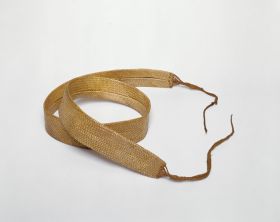Belt tatua
Place: New Zealand
Category: Clothing
flax, New Zealand, l. 128 cm, w. 6 cm, Inv. Oz 322
Humphrey No. 49 (?): ‘A matted Belt, worn by the Men of New Zealand.’
Belt made of flax, ending at each end in a plaited band, the weave turned inward on both sides.
Many belts were collected in addition to cloaks during Cook’s voyages; Kaeppler mentioned seventeen (Kaeppler 1978a: 175). Comparable belts can be found in the collections in Cambridge (Kaeppler 1978a: 175, Fig.328; Shawcross 1970: 325-30), Stockholm (Rydén 1965: 89f.), in the British Museum (Kaeppler 1978a: 175), and in Florence (Giglioli 1893: 185f.).Rydén distinguished between belts with a straight or pointed end. Some belts are patterned with dark flax strips. The end of the belt features plaited flax cords for fastening. The belts were used to support the cloaks; men would also use them to hold their clubs. Markus Schindlbeck
Sources
Giglioli, Enrico H, Appunti intorno ad una collezione etnografica fatta durante it terzo viaggio di Cook, Florence, 1893.
Kaeppler, Adrienne L, ‘Artificial Curiosities’ Being An Exposition of Native Manufactures Collected on the Three Pacific Voyages of Captain James Cook RN [Exhibition catalogue], Bishop Museum Press, Honolulu, 1978a.
Rydén, Stig, The Banks Collection: An Episode in 18th Century Anglo-Swedish Relations, The Ethnographical Museum of Sweden Stockholm Monograph Series, no. 8, Goteborg, 1965.
Shawcross, Wilfred, ‘The Cambridge University collection of Maori artifacts, made on Captain Cook’s “first voyage”‘, Journal of the Polynesian Society, 1970, vol. 79, no. 3, pp. 305-348.

